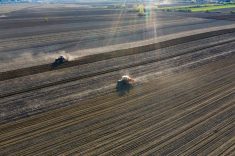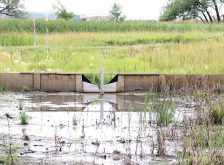Farming has existed in one shape or form for more than 10,000 years. While farming methods have evolved considerably over that time, one thing that has remained the same is a desire among producers to get the most possible out of their land.
Improving every acre was the focus of a panel discussion at Canola Week 2022, an in-person and online event held Dec. 6-8, 2022, in Saskatoon, Sask., that focused on the state of the canola industry, cutting-edge technologies, agronomic issues and research.
Marla Riekman is a soil management specialist with Manitoba Agriculture and Resource Development who specializes in improving soil productivity. She spoke at the event about soil quality and what steps producers can take to improve it in their fields.
Read Also

Claas brings 1000 Series SP forage harvesters to Canada
In mid-August, Claas unveiled its new line of Jaguar forage harvesters at an event in Visalia, California, deep in the heart of that state’s dairy region.
Riekman said one of the key factors farmers must take into account when it comes to soil quality is variability, including how the topography of a field can vary from location to location.
No one-size-fits-all solution
“We need to recognize that treating a field as one big square might work if your field is extremely flat and doesn’t have a lot of topography,” she explained. “Otherwise, we might have to do some kind of different management across the field if you want to improve those acres or improve management across those acres, recognizing that sometimes some of those acres are not meant for annual ag crop production.”
Riekman added ignoring variability in a field and applying the same amount of fertilizer year after year can increase variability and lead to fertilizer not being used appropriately in some locations.
How can growers address the issue of variability within their fields? Riekman says the key to doing that is building soil resilience. Building resilience in the soil will help it adapt to all of the different challenges it has to contend with during a growing season and improve overall crop growth. Healthy soil can also help better absorb precipitation and hold moisture, she added.
Riekman said there are a number of tools farmers can use to help build soil resilience. First and foremost is making good cropping choices and choosing suitable rotations. Another is the use of perennial and cover crops, especially in low-lying areas or areas that are not producing well and might need a little added TLC to build resilience. For those regions and circumstances where it is appropriate, cover crops can help build up carbon in the soil as well as combat organic matter loss.
“When it comes to cover crops, they can be very beneficial if you have a wet fall and you are trying to dry (the soil) down. It serves a very specific purpose in this case,” she said. “It can, in those cases, help you traffic a field with higher moisture content without causing the same level of compaction because if there’s enough of a root system, it may actually help carry some of the weight of the equipment.”
However, Riekman cautioned farmers not to think of cover crops as a cure-all for dealing with soil compaction.
Cover crops not a cure-all
“When they come out with a tillage radish that’s called Jackhammer, it really makes you think you’re going to bust through whatever compaction you have,” she said. “My caution with this is it’s a taproot and it does have the ability to push a little harder through some of these compacted soils, but roots can’t be expected to grow through everything.
“We need to think about not causing the problem (rather than) just assuming the crop is going to fix it for us. We need to think more about not causing the problem in the first place.”
Although terms like soil health and soil biology have become buzzwords in the agricultural industry, Riekman said one thing that often gets overlooked is the importance of soil structure. In simple terms, soil structure is how solid particles and the spaces between them are arranged in the ground.
Riekman said soil structure is important because it not only allows for water movement, but it can also promote biological activity, root growth and proper seedling emergence.
“Soil biology — that’s a hot topic right now. But you can’t give the biology a home to live in that is appropriate if the soil is very compacted,” she said.
“Building soil structure comes from the physical, chemical and biological processes working together. That aggregate stability … and how well they withstand the impacts of wind and water, that comes from a healthy soil with healthy biology. These things have to work together. We can’t think of them individually. Having a better structured soil is going to set yourself up for success.”
Tile drainage
David Whetter is the principal soil scientist for AgriEarth Consulting, a Winnipeg-based company that provides clients with agricultural and environmental advice on a host of subjects including soil management, soil water management, nutrient management and sustainability. He spoke at Canola Week about tile drainage and the effect it can have on soil.
Tile drainage is the placement of perforated pipes in the soil below the rooting zone, which allows farmers to lower the water table in the ground. With tile drainage, roots have better access to oxygen, which in turn promotes better plant growth and ultimately better yields. A tile drainage system is comprised of three basic components: perforated pipes that collect water underground, solid pipes that move the subsurface water elsewhere and an outlet where that water is released.

Whetter said tile drainage is best suited for use in areas that have excess moisture in the ground. The primary benefit to producers is increased yields, he explained. A study conducted by the University of Minnesota showed tile drainage led to yield increases of 10 to 20 per cent in some parts of North America.
Another important benefit of using tile drainage, Whetter explained, is that it can allow farmers to get onto their land earlier in the spring and begin seeding sooner. He said data from Manitoba shows if a farmer is delayed from seeding beyond the second week of May, it can result in reduced yield potential of as much as five to 10 per cent per week, depending on the crop.
“If tile can help get farmers on that field a week or two earlier, there’s an obvious benefit,” he said, adding that tile drainage can also reduce the risk of crop losses from excess water in season.
Tile drainage can also play an important role in reducing soil salinity in fields, which can significantly limit plant growth and is an important management issue across the Prairies, Whetter said. By installing a tile system below the surface, it’s pulling the water table down and reducing or eliminating the chance of salt in the groundwater being drawn to the surface. Filters can help trap that salt.
However, Whetter said reclaiming land affected by soil salinity is a long-term process and tiles are not a “magic and quick fix for soil salinity.” In fact, it can take as long as 15 years to see significant results, he added.
One of the most important decisions a farmer can make when it comes to installing a tile drainage system is choosing the right type of drainage outlet. There are two types of drainage outlets. One is a gravity outlet where regional elevation allows gravity to carry the water to its ultimate destination. With flatter landscapes like the Prairies, a pump outlet is often required to draw that water into a drainage ditch.
“If you don’t have a good drainage outlet, you don’t have a good drainage project,” Whetter said.
It’s also important for farmers to consider the effect drainage tiles can have downstream before installing a system, he added. That includes talking to neighbours and learning what regulatory requirements your municipality may have. The good news is tile drainage can ultimately lead to reduced surface runoff and sediment losses.
Drain depth is another essential consideration when it comes to installing tile drainage. Whetter said a minimum of two and a half feet of ground cover is typically required to maintain the integrity of the pipe. He also cautioned growers to consider the potential for restrictive layers in the ground that may be caused by compaction or other soil structure issues. If tiles are placed below a restrictive layer that could result in some serious performance issues, he said.
How can a producer determine if tile drainage is right for their fields?
Although it can reduce certain drainage limitations, especially in imperfect and poorly drained landscapes, Whetter stressed farmers should remember it is a complementary practice to surface drainage and surface drainage should always be considered first when it comes to implementing drainage improvements.
Tile drainage isn’t a cheap solution, either. Whetter estimated it can cost between $1,000 and $1,500 an acre to install a system depending on a number of factors including the lateral spacing that might be required. He added there are several different assessment tools available to farmers to help determine if tiles are right for them including yield maps, topography investigations and real-time water table sensors.
One of the most promising aspects of tile drainage, Whetter said, is that it’s being used more and more to capture subsurface moisture, which can then be recycled through surface or subsurface irrigation.
Farm the best acres
Mark McConnell is an assistant professor at Mississippi State University (MSU) and a wildlife ecologist by training. He’s also an expert on how precision agriculture and conservation can be used to increase farm-level profitability in the United States.
McConnell spoke at Canola Week about how returning marginal acres to conservation land south of the border helped producers there increase farm revenues while also benefitting the environment.
“A lot of people in the supply chain are being pressured to show conservation footprints and benefits and this is one way to do it — farm the best acres, and let’s do something else with the rest of them,” he said.

U.S. farmers often ask McConnell and his associates how to utilize marginal land most effectively. As a result, McConnell’s department developed software known as the MSU Precision Conservation Tool. The decision-making software helps identify precise locations where conservation practices are most economically beneficial to farmers on specific sections of their fields. The tool is available to U.S. growers on a subscription basis. Its goal is to ensure converting marginal land to conservation areas results in increased revenues for growers as part of an economically targeted approach to conservation.
“If we target those traditionally low-producing areas, those hotspots, those flood-prone areas … and if we can do it in an economical way and find the acres that are most challenging, we can increase whole-field profitability (and) provide a lot of ecosystem services (at the same time),” he said.
“Finding a way to diversify the investment portfolio of your field and taking risky elements like soils and making them less risky through conservation is an interesting approach. Hopefully if we can do that we can (meet) the environmental objectives for the landscape that society has put on the shoulders of farmers, but also do it in a way that is economically beneficial to them,” said McConnell.
Not only did this targeted approach to conservation help with farmers’ bottom lines, McConnell said it can also provide a boost to local ecosystems. For example, he said converting marginal farmland to conservation areas often attracts more birds that feed on insects to an area, which can result in reduced insect pressure on crops in nearby fields. It can also help to make an environment more environmentally resilient, he added.
“We (need to) find new and innovative ways to (enhance the landscape) in a way that is profitable to the farmer and makes it much easier for them to accomplish,” he said.
Canadian farmers can use precision agriculture and technologies that support the decision-making process. These tools help identify low-productivity farmland that can be shifted to conservation projects like seeding marginal lands to forage or enrolling in conservation and restoration programs available through agencies like Ducks Unlimited Canada.
















